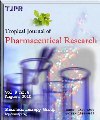
|
Tropical Journal of Pharmaceutical Research
Pharmacotherapy Group, Faculty of Pharmacy, University of Benin, Benin City, Nigeria
ISSN: 1596-5996
EISSN: 1596-5996
Vol. 15, No. 10, 2016, pp. 2099-2106
|
 Bioline Code: pr16278
Bioline Code: pr16278
Full paper language: English
Document type: Research Article
Document available free of charge
|
|
|
Tropical Journal of Pharmaceutical Research, Vol. 15, No. 10, 2016, pp. 2099-2106
| en |
Bioactive content, hepatoprotective and antioxidant activities of whole plant extract of Micromeria fruticosa (L) Druce ssp Serpyllifolia  F Lamiaceae against Carbon tetrachloride-induced hepatotoxicity in mice F Lamiaceae against Carbon tetrachloride-induced hepatotoxicity in mice
Abu-Gharbieh, Eman & Ahmed, Naglaa G
Abstract
Purpose: To investigate the antioxidant and hepatoprotective activities of Micromeria fruticosa Druce
(L.) Druce ssp Serpyllifolia F. Lamiaceae (MF) extract and to correlate its phenolic composition of the
biological activities.
Methods: Reversed-phase high-performance liquid chromatography (RP-HPLC) was employed for the
identification and quantification of phenolics. 2,2-Diphenyl-1-picrylhydrazyl (DPPH) radical scavenging
potential of the four extracts, namely, ethanol, methanol, acetone, and ethyl acetate, were assessed.
The hepatoprotective and antioxidant activities were evaluated against carbon tetrachloride (CCl4)-induced hepatotoxicity in mice. Antioxidant status in the liver was assessed by determining the activities
of some antioxidative enzymes, namely, superoxide dismutase (SOD), catalase (CAT) and glutathione
peroxidase (GSH-Px), and the levels of thiobarbutaric acid reactive substances (TBARS).
Results: RP-HPLC analysis revealed high contents of quercitrin, rosmarinic and ferulic acid. The four
extracts were potent DPPH free radical scavengers. Administration of the ethanol extract to the animals
twice daily for 14 days did not show any evidence of hepatotoxicity. CCl4 caused a marked increase in
TBARS and significant decrease in CAT, GSH-Px and SOD levels, but this was reversed by the ethanol
extract.
Conclusion: The ethanol extract of Micromeria fruticosa (L) may have a palliative effect in liver injuries
and this is probably due to the antioxidant properties of the plant’s polyphenolic content.
Keywords
Micromeria fruticose; Phenolics; Hepatotoxic; Hepatoprotective; Antioxidant; Quercitrin; Ferulic acid; Rosmarinic acid
|
| |
© Copyright 2016 - Pharmacotherapy Group, Faculty of Pharmacy, University of Benin, Benin City, 300001 Nigeria.
Alternative site location: http://www.tjpr.org
|
|
